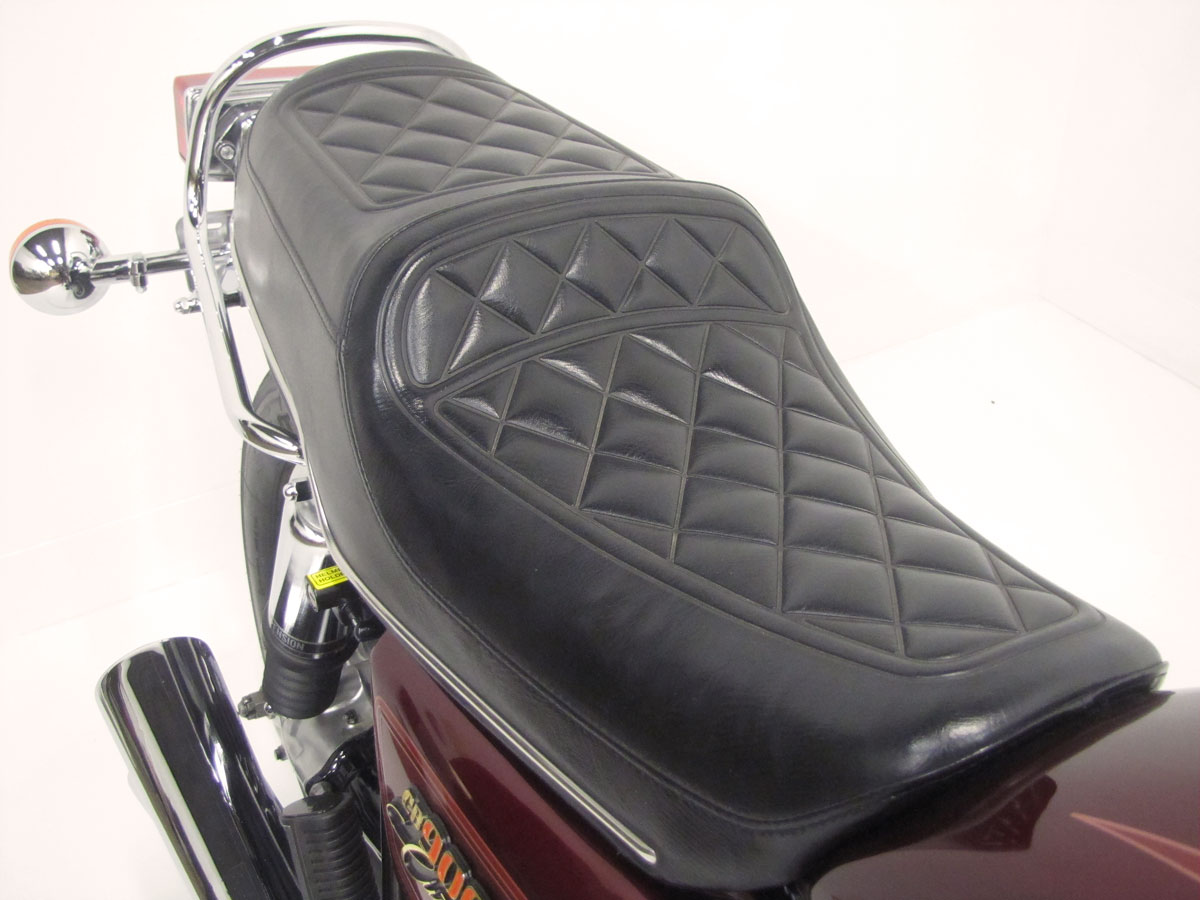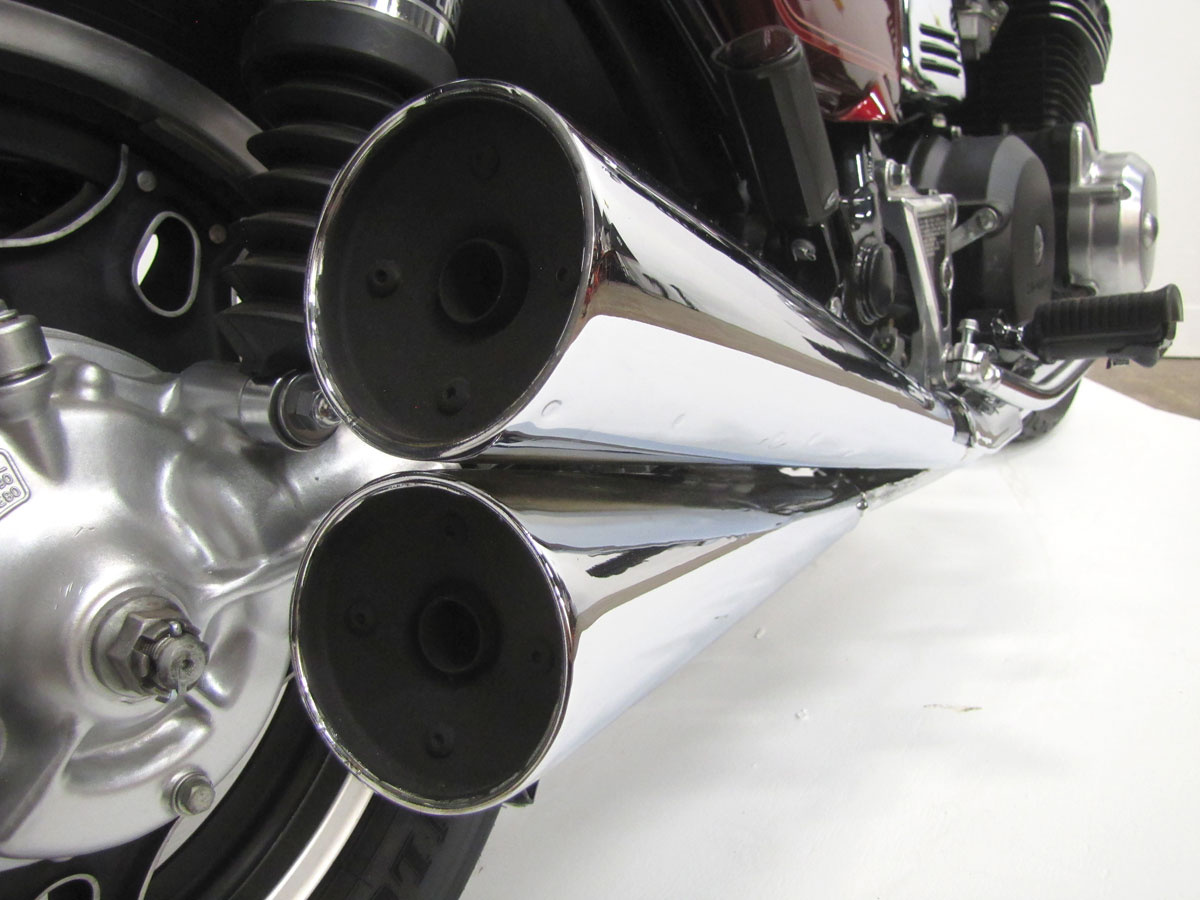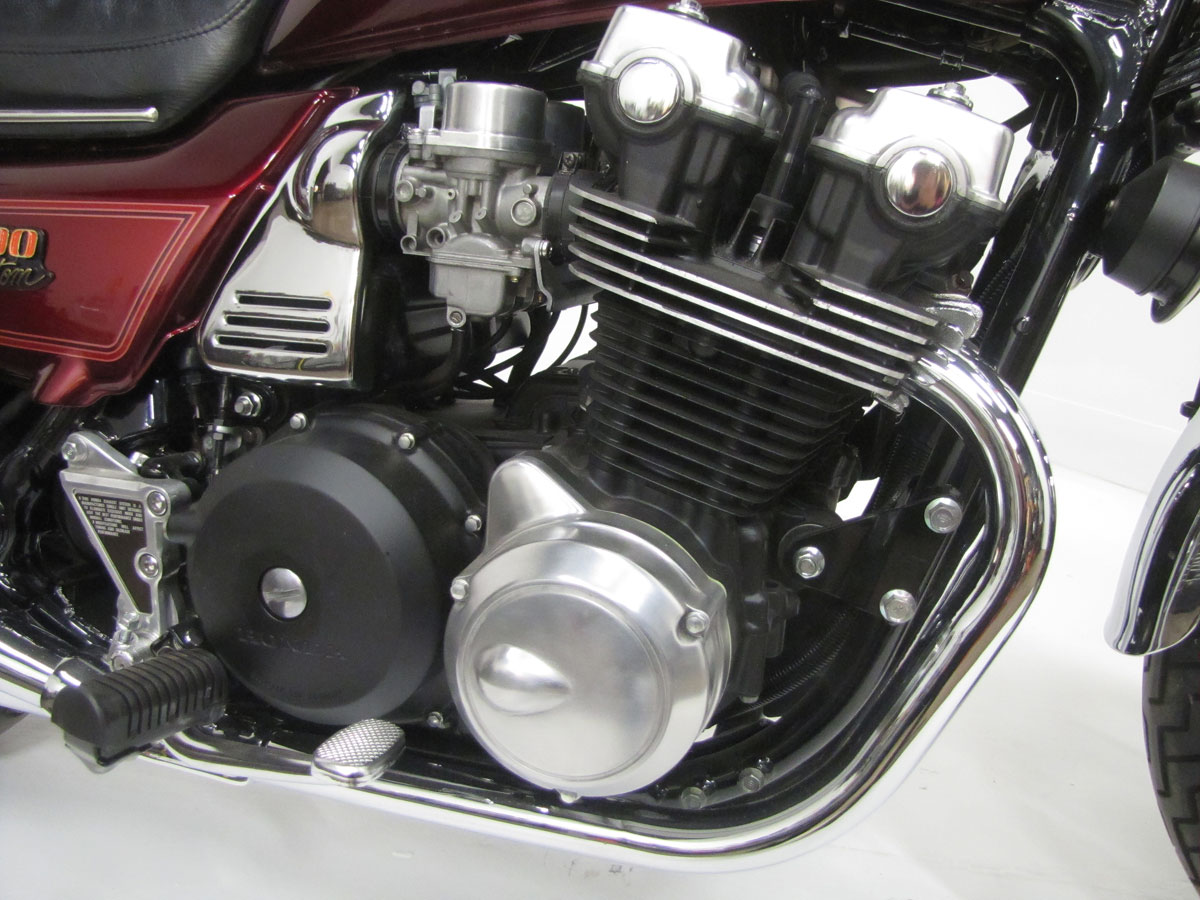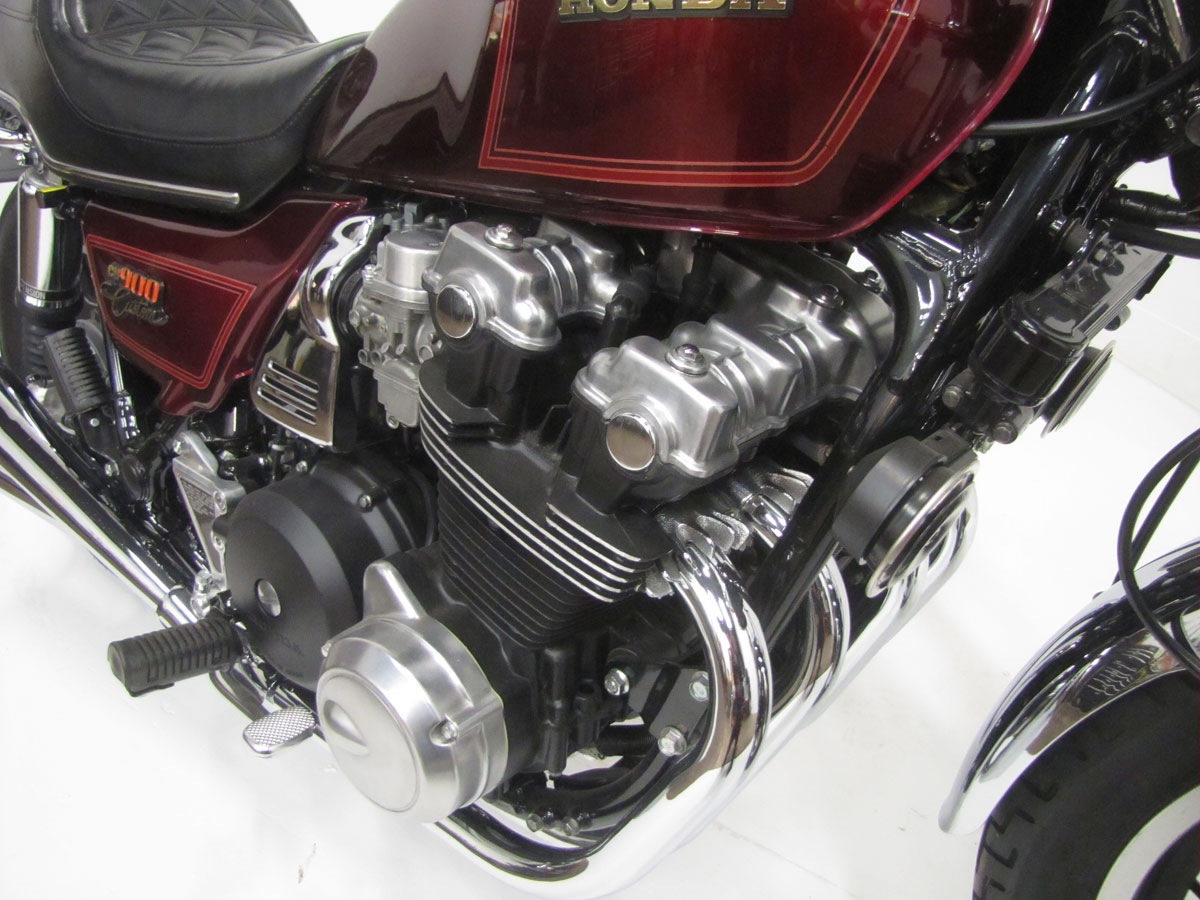
Looking at offerings up to the mid-1970’s, things were pretty simple. There were just “standard” models of the Suzuki GS550, GS750, Honda CB350F, CB550, CB750, the standard XS650 twins from Yamaha, the Kawasaki KZ400 four and the Z1, a 900 which became the Kawasaki KZ1000.
Then most likely observing Harley-Davidson’s offerings, these manufacturers noted a trend toward a “mild lean back” riding position. This called for a new version of the basic machine, a higher handlebar and lowered/stepped seat and possibly moving the footpegs forward a bit. Kawasaki did it best first, most would agree, with the KZ900LTD and KZ1000 LTD. Doing a rework of the CB750F/CB900F and CB750K models, Honda followed suit in 1980 and added the CB900 Custom to their lineup, later the punched out CB1000C.
The original Honda CB750 was powered by a single overhead cam four cylinder engine. This was the beginning of the “universal Japanese motorcycle” and not a bad thing. After a 1969 to 1978 production run of the SOHC CB750, a completely new engine arrived in 1979 in the form of the DOHC CB750F and CB750K. These were more sophisticated and higher output DOHC-powered machines. Honda moved toward the CB750C /CB900C models with cleaner, easier to maintain shaft drive; now there were three versions of CB750 and CB900. While they were at it, they added a dual range transmission to the already in place 5-speed giving the C models 10 speeds. This reportedly dropped cruising RPMs by about 500 and increased fuel mileage. Luckily all this complication in the driveline was Honda durable. In 1978, after making only traditional spoke wheels for decades, Honda brought out the Comstar wheel. Each wheel is made from an aluminum hub and rim and ten steel spoke stampings all riveted together. It mimics a mag wheel with no confirmation of weight savings, though use of an all-aluminum Comstar version in factory road racing says it’s strong. The CB750K’s got traditional spoke wheels, F’s and C’s got the Comstars. Custom colors for 1982 were two-tone blue or two-tone red.
By 1982 Honda chose the all new liquid cooled DOHC Vee-Four engine design for most of their top flight 750 to 1100cc machines, the Sabre and Magna and in 1983 the then-radical VF750F Interceptor sport bike. The V-Fours replaced many of the across the frame air-cooled four cylinder-powered Hondas. More complex and no lighter, the V-4 worked well in cruiser designs as it was narrower mimicking somewhat a V-Twin. So this smooth, sweet traditional across the frame four left the Honda lineup. Not only that but the Shadow V-Twin line-up hit in 1983 as Honda moved quickly to figure out what riders wanted. How it sat, how it looked and how it sounded were all extremely important. The CB900C, and later the CB1000C were excellent bikes built up from a standard in-line four, but too conventional as motorcycle design started a path toward extreme specialization.
Specifications:
-
- Engine: Transverse Four-Cylinder DOHC
- Type: Air-Cooled, Wet Sump
- Bore & Stroke: 64.5mm x 69mm
- Displacement: 902 cc
- Ignition: Electronic
- Carburetor: Four 32mm Keihins
- Compression Ratio: 8.8:1
- Horsepower: 95HP / 9000RPM Redline
- Starting: Electric
- Primary: Hy-Vo Chain
- Clutch: Wet, Multi-plate
- Transmission: Dual Range 5-Speed
- Final Drive: Shaft Driven
- Frame: Tubular Steel, Duplex
- Suspension: Hydraulic / Air Fork / Swingarm, Dual Air Shocks
- Brakes: Dual 280mm Disk Front / 297mm Disk Rear
- Wheelbase: 58.5 Inches
- Wheels/Tires: 110/90 x 19 / 130/90 x 16
- Weight: 588 Pounds
- Top Speed: 135 MPH
Leave a Reply
Want to join the discussion?Feel free to contribute!




































Beautiful example, but they weren’t much of motorcycle when they were new. Are you getting low on bikes to display? Would rather see a MZ 250 or Rikudo. Old rat 350 Honda choppers would be more interesting. Keep trying. Usually I am happy to see what you have just not today. Rick
Rick,
Thanks for writing. At this point we have posted on the Museum website about 280 Museum bikes’ stories of the 550 some machines on display. As a motorcycle museum it is our duty to cover all aspects of the history of motorcycles and to share that with our visitors; some bikes will bore some Museum supporters, others will recall family history, or dreams. We are very proud to have received this stunning example as a donation, restored and painted by the owner. And we are happy to be able to use it to tell the story of that era of motorcycle design. Stay tuned and hopefully you’ll again see something you like. (We featured the Rikuo some time back and it’s on our website, as are all past Featured Bikes, searchable by name.)
Thanks,
Mark
National Motorcycle Museum
No much of a motorcycle? Exactly what do you mean?
The cb900c is one of the best looking and best handling bikes of it’s time, will out do some of the bikes today. I know owned one just like the one shown here and have a blue one now that l will not depart with.
Hey Ricky just letting you know I just now scored a blue CB900 custom it been setting up for a while in a garage but it’s an extremely good shape the brakes are seized on it so I’m having to get new calipers I do anticipate writing it anything I need to know specifically about this bike any hints or tips would definitely be welcome
I just bought my second cb900c both the burgundy rode first for ove 10,000 miles can’t wait to put another 10,000plus on second
I have owned two cb900c’s floats like a cloud and runs toe to toe with xs1100
No mention of the 1978 Yamaha XS750? An in-line triple with shaft drive in the laid back cruiser style. The XS 650 was mentioned but the 750, upgraded to an 800 and then a 4 cylinder 1100 was added. I guess Honda was bigger then.
Dude, all excellent motorcycles! This bike is unique and beautiful both, fit and finish flat awesome, and truly, quite a handful of motorcycle! I have owned three and traveled extensively on them You can do a lot worse for a long distance cruiser!!!!
Thanks for the article. I had my share of Honda in line fours: CB350F, CB650 Custom, Nighthawk S, CB1100F. Also had a few of the Honda V4’s: VF750 Interceptor, V65 Sabre, and the awesome, tariff skirting VFR700 Interceptor. Wishing I still had a few of them! Keep up the great work!
Michael,
Regarding Yamaha’s offerings, the XS750 triple hit in 1976 and I was speaking of “…up to the mid-1970’s” in my write-up. Lots happened after 1975. Interesting that by then Suzuki, Kawasaki had pretty much abandoned their two-stroke triples and moved to in-line four-stroke fours in several sizes. Imagine the tooling costs and the shift in engineering work. Exciting times, and a lot to remember, as were the early 1980s and a whole new round of true Superbikes; liquid cooling, V4’s, single shock rear suspension, 16 inch front wheels, perimeter and alloy frames, full “road race”fairings from the factory.
I’d also like to see something on the XS1100. I still dream of owning one once I have a garage. To me these bikes look like what a motorcycle should look.
This is the only XS650 I found on your site: https://nationalmcmuseum.org/2014/09/29/classic-yamaha-650-donated-to-the-national-motorcycle-museum/
…which is cool as it’s stock. But do you have any XS rides from the later 70s or early 80s? That’s when they came into their own style-wise.
I own a 1980 CB900C and I had put it into storage for over 22 years. I had a buddy go through the whole thing and he got the thing road worthy for me and I put 10,000 miles on the thing for 2 years in a row, the bike is in super condition and I like it as a spare to my 2013 HD Limited.
I have a 1980 Honda CB 900 and I was wondering how many were manufactured it were manufactured in 1980 81 and 1982
In 1980 I was interested in s Yamaha 850 shaft drive. The dealer in Baltimore sold Yamaha and Honda. The owner, who had been in business for 40 years said the 850 was one of the most troublesome bikes he ever had to sell. He pointed to a CB900C and said it was a better choice. The 900 was more expensive so I had to wait before getting one. My girlfriend (later wife) and I rode it all over the East Coast. I still ride it regularly and it has provided 41 years of trouble free enjoyment. Sometimes I read a guy saying it is not a real good motorcycle and wonder if they ever owned one.
I owned one in the 80’s when I was stationed at Moody AFB Georgia. Loved it. Rode it all along the southern coast. Brought it home to Ky, rode to Ohio, Indiana, North Carolina. Great bike.
Hola a todos. He tenido muchas motos de màs de 500cc, Triumph, BMW, Kawasaki, Yamaha, y he visto que todas tienen su particularidad, en su desempeño, potencia, sonido, postura o diseño. Todas vàlidas para cada gusto, pero les aseguro que en mi caso, nunca encontrè en una sola moto todo junto. Tengo la Honda CB900C hace unos años, y no hay vez que la use que no despierte admiraciòn a su paso. Es una moto referente, inspira seguridad y nobleza. Para mi es la mejor. Si pueden prueben una y luego comenten. Saludos.